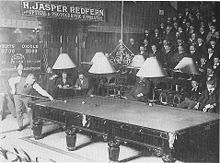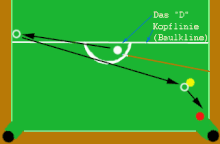English billiards

English Billiards (or simply called "Billiards"), which is now regarded as the first popular variant of hole billiards , originated in England in the 18th century. The game is played on a 12-foot table with six pockets, which today is commonly referred to as the snooker table, especially outside the British Commonwealth of Nations , which is historically incorrect because snooker emerged from billiards and not the other way around. English Billiards, which is played with three balls, is still popular in Great Britain and the British Commonwealth of Nations today , albeit now ranking behind snooker. Especially in England , India , New Zealand and Australia , but also in Thailand , South Africa and Austria , this variant still has a loyal following.
history
There are numerous theories about the origin of the game of billiards. The only irrefutable fact is that next to nothing is known of its history prior to the 17th century. The first detailed description can be found in Charles Cotton's book The Compleat Gamester from 1674, which mentions, among other things, the spread of the game of billiards throughout Europe and its particular popularity in England. There is also a diagram of a rectangular table in the proportions that are still common today with six pockets.
English Billiards was the first version of billiards, which, due to the colonial policy of the British, found worldwide distribution in the 18th and 19th centuries. Not only in the colonies of that time, also in the USA, for example (due to the wave of emigration in the 19th century), the game of English billiards with the corresponding tables was the first known and popular form of billiards.
The first world champions in billiards history were determined in English Billiards, albeit in keeping with the spirit of the times. Since Edwin Kentfield in 1825 and John Roberts Sr. were both "declared" champions in 1849, the match between William Cook and John Roberts Sr. in February 1870 is the first game for the world championship crown in the history of billiards.
Since those days (with a few exceptions) the professional world champion has been determined annually , since 1926 (usually annually) amateur world championships have been held. In 2012, the IBSF and WPBSA World Championships were held in one joint event for the first time. The previously common distinction between amateur and professional players is no longer given.
regulate
English Billiards is a game for two people or two teams. Both parties have their own cue ball, which is either white or yellow, a red object ball completes the set.
The aim of the game is to score points by sinking balls or with a collision. Punching the red object ball is called winning hazard and earns three points. The red ball is then placed back on the top spot (the place of the black ball in snooker). Another possibility of the winning hazard is to punch the someone else's game ball. However, this only earns two points and the opponent's cue ball remains off the table until this recording is over (the opponent then starts his series with his cue ball by hand and plays from the "D").
The Losing Hazard is achieved by the own game ball is perforated by contact with one of the other two balls. If this is the foreign ball, a losing hazard is rewarded with two points and with the red object ball with three points. The player continues the recording by playing from the "D".
The third and final possibility of getting points is to bring your own cue ball into contact with both the foreign cue ball and the object ball. This is called a cannon and is awarded two points.
Combinations of cannons and hazards are also possible. A maximum of ten points can be achieved with one push (Hazard over the object ball plus cannon, then all three balls fall into the pockets).
When playing your own game ball by hand (from the "D"), only balls outside the head field (Baulk area) may be hit directly. This rule forms the basis for getting the opponent through defensive play into situations in which he is not allowed to play the ball directly. In this case, an attempt can be made to hit a ball over the front rails outside the head field. If this does not succeed, 2 foul points are awarded to the opponent and the game continues.
At the start of the game, the red object ball is placed on the top spot. The opening shot is in-hand (from the "D"), the opposing game ball is not at the table at this time. Common variants are to play the red ball in the head field and to place your own game ball near the side board at the height of the pyramid spot or to bring both balls into the head field.
In the event of a foul (e.g. penetration or shooting the ball off the table), the opposing party receives two points and can take over the situation at the table or have the basic position (red on the spot, opposing ball in the center spot) built and from the "D" keep playing.
It is played either for a predetermined amount of time or until one of the participants reaches a predetermined score.
| perforated | own ball hits | Pt. |
|---|---|---|
| no ball | 1st foreign ball, 2nd red ball | 2 |
| no ball | 1st red ball, 2nd foreign ball | 2 |
| own ball | 1st foreign ball | 2 |
| strange ball | 1st foreign ball | 2 |
| strange ball | 1st red ball | 2 |
| own ball | 1st red ball | 3 |
| red ball | 1st foreign ball | 3 |
| red ball | 1st red ball | 3 |
| own ball | 1st foreign ball, 2nd red ball | 4th |
| strange ball | 1st foreign ball, 2nd red ball | 4th |
| strange ball | 1st red ball, 2nd foreign ball | 4th |
| own + foreign ball | 1st foreign ball | 4th |
| own ball | 1st red ball, 2nd foreign ball | 5 |
| own + foreign ball | 1st red ball | 5 |
| own + red ball | 1st foreign ball | 5 |
| red ball | 1st foreign ball, 2nd red ball | 5 |
| red ball | 1st red ball, 2nd foreign ball | 5 |
| foreign + red ball | 1st foreign ball | 5 |
| foreign + red ball | 1st red ball | 5 |
| own + foreign ball | 1st foreign ball, 2nd red ball | 6th |
| own + red ball | 1st red ball | 6th |
| own + foreign ball | 1st red ball, 2nd foreign ball | 7th |
| own + red ball | 1st foreign ball, 2nd red ball | 7th |
| foreign + red ball | 1st foreign ball, 2nd red ball | 7th |
| foreign + red ball | 1st red ball, 2nd foreign ball | 7th |
| all balls | 1st foreign ball | 7th |
| own + red ball | 1st red ball, 2nd foreign ball | 8th |
| all balls | 1st red ball | 8th |
| all balls | 1st foreign ball, 2nd red ball | 9 |
| all balls | 1st red ball, 2nd foreign ball | 10 |
Known players
From William Cook and John Roberts Jr. in the 1870s and 1880s, to Melbourne Inman at the beginning of the 20th century, Tom Newman , Joe Davis and Walter Lindrum in the 1920s and 1930s, to Rex Williams in the 1970s and 1980s there were always players who dominated an era. For around 20 years, Mike Russell from England and the Indian Geet Sethi , who have both been world champions nine times, have had a firm grip on the top of the world. The outstanding representatives nowadays include Peter Gilchrist (from England, but starting for Singapore) and the multiple IBSF World Champion Pankaj Advani from India.
For women, Joyce Gardner dominated the 1930s, Thelma Carpenter the 1940s, Maureen Baynton the 1960s and Vera Selby the 1970s. Emma Bonney and Kelly Fisher (both from England) as well as the Indian women Chitra Magimairaj and Anuja Chandra are among the most successful women of the new millennium .
World record
In the history of sport, players have repeatedly developed unusual, mostly repetitive methods to increase the level of their series of points, sometimes extremely. Usually the rules were changed by the responsible control body (formerly Billiards Association and Control Council) after they were displayed. This resulted in records in the historical periods that are only partially comparable.
The current world record for the longest series in a tournament match is held by Peter Gilchrist with 1,346 points in one shot , achieved at the New Zealand Open 2007. In this match, Gilchrist set a new record average of 426 points per shot.
Walter Lindrum earned a record series of 4,137 points in a match against Joe Davis on January 20, 1932 . The recording lasted 177 minutes and consisted mostly of series of billiards.
The highest ever played and recognized series was in a two-week long batch of Jr. William Cook achieved. In a game against Alec Taylor in London on June 4, 1907, Cook completed a series of 42,746 points.
Tom Reece succeeded in an even higher series a short time later , who produced a total of 499,135 points in one recording over five weeks, completed on July 6, 1907. Even under the regulations of the time, this series was not recognized, however, as it was not consistently proven by witnesses has been.
Today you can only punch a ball 15 times in a row or play a collision 75 times.

